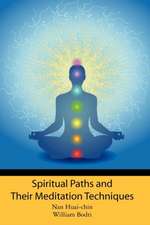The Little Book of Hercules: The Physical Aspects of the Spiritual Path
Autor William Bodrien Limba Engleză Paperback – 30 iun 2011
Preț: 191.91 lei
Nou
Puncte Express: 288
Preț estimativ în valută:
36.73€ • 39.88$ • 30.85£
36.73€ • 39.88$ • 30.85£
Carte disponibilă
Livrare economică 01-15 aprilie
Preluare comenzi: 021 569.72.76
Specificații
ISBN-13: 9780972190718
ISBN-10: 0972190716
Pagini: 434
Dimensiuni: 152 x 229 x 22 mm
Greutate: 0.58 kg
Editura: Top Shape Publishing, LLC
ISBN-10: 0972190716
Pagini: 434
Dimensiuni: 152 x 229 x 22 mm
Greutate: 0.58 kg
Editura: Top Shape Publishing, LLC
Descriere
Using the Greek story of the Twelve Labors of Hercules, which outlines the progressive stages of spiritual development that spiritual practitioners in all spiritual traditions go through, this book presents full details on the step-by-step progression of the physical transformations that occur to practitioners. Whenever someone starts to consistently cultivate spiritual practice in a devoted way, there are physical changes that will occur to the human body. These physical transformations, called "gong-fu" in the eastern spiritual schools, are non-denominational signposts of spiritual progress. If you cultivate spiritual practice sufficiently then these phenomena will arise. If you don't practice correctly, they simply won't appear. Their appearance is a matter of proper devoted effort. These phenomena include such things as the awakening of kundalini (yang chi) within the body, the opening of the chakras and purification of the body's energy channels, hormonal transformations, the calming of consciousness, the experience of refined mental states described as "emptiness," and various other mental and physical phenomena. Normally people think these phenomena only occur to individuals following eastern cultivations traditions such as yoga, Buddhism, Hinduism, Taoism, and Vajrayana. However, these phenomena that arise are totally non-sectarian and non-denominational. They equally occur to devoted spiritual followers within Judaism, Islam, and Christianity. If you cultivate spiritual practices sufficiently, these purification transformations will occur and if you don't cultivate meditation or other spiritual exercises, you will not experience them. Your religion has nothing to do with it. All genuine religious traditions employ cultivation practices designed to help you achieve a quiet mind. Because thoughts die down due to these practices, this resulting mental quiet is described as peacefulness, silence, cessation, calming, purity, and emptiness. Your mind empties of busy thoughts and so you begin to experience mental peace. When your mind quiets, proper spiritual practice requires that you remain aware during this experience rather than try to suppress thoughts from further arising. The practice of maintaining awareness while mentally quiet is called witnessing, observing, knowing, or introspection. As the mind quiets, you continue to watch your mental continuum but without attaching to it. The gradual calming of your mind results from successfully letting go of thoughts, and because your body's life force (chi) and consciousness are linked, as you let go of thoughts you also drop the habit of clinging to the energies you normally feel in your body. With proper spiritual practice you learn how to detach from these energies and let them function without interference. Once you learn how to do this, your kundalini energies will arise and their natural circulation will start to transform your body. Those energies will open up your chi channels and chakras and transform your physical body, purifying it. As your chi purifies, so will your emotions and habit energies. As you progressively let go of your chi, it will also revert to its natural circulation which has been suppressed by errant thought patterns. Cultivating a quiet mind leads to your kundalini arising, those energies purify your channels and chakras, that purification leads to a greater degree of mental purity or emptiness, and the two components of body and mind reach ever increasing levels of refinement. This book presents full details on this step-by-step progression of transformations that occur to practitioners on the spiritual trail. It covers the meditation practices that successful adepts have traditionally used throughout history, and non-denominationally links the gong-fu experiences of these practitioners with the stages of the spiritual path and the ultimate quest for self-realization, or enlightenment.





















